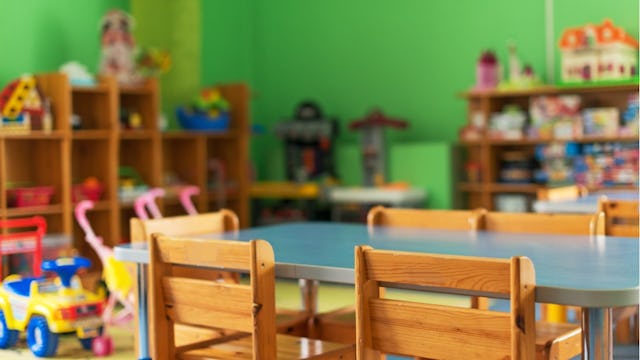Schools Are Cutting Down On Playtime, And This Is Why It's So Harmful

My youngest son started Kindergarten a couple months ago, and since I had done this transition once before with my older son, I wasn’t as concerned about the same things that had me worried sick the last time around. I knew that even if my little guy was sad to say goodbye to me, he would adjust. I knew that he would make friends (eventually), get comfortable peeing in the school bathroom (eventually), and acclimate to the longer, jam-packed days (eventually).
Nope, what I was worried about most was the massive push toward a more academically-oriented kindergarten that has happened in the past few years. My older son started kindergarten five years ago, and even in that short time, there has been an even greater shift toward “academic rigor” in the pre-K and kindergarten classrooms.
A study published in 2016 by the American Educational Research Association, for example, highlights many of these changes, with educators quoted in the story describing early education of today as “characterized by a heightened focus on academic skills and a reduction in opportunities for play.” The researchers surmise that the kindergarten of today is pretty much how first grade was just a few short years ago.
Yikes, right? As a mom of a new kindergartener, this sort of thing is enough to give me a mini-panic attack.
Nancy Carlsson-Paige, a professor of education at Lesley University, seems to be in agreement with this characterization of the demise of early childhood education. Carlsson-Paige, who is the author of Taking Back Childhood and the recipient of numerous esteemed educational awards, gave a speech about this topic in 2015.
In the speech, she describes early education as “twisted” and remarks: “Never in my wildest dreams could I have foreseen the situation we find ourselves in today.”
The speech, published in full in The Washington Post, was Carlsson-Paige’s acceptance speech for the Deborah Meier award, presented to by the National Center for Fair and Open Testing. And let me tell you: the speech is incredibly eye-opening—albeit depressing—and totally worth checking out.
Carlsson-Paige starts by generally critiquing the push toward academics and the pull away from more unstructured playtime. Besides the fact that, as Carlsson-Paige explains it, “decades of research in child development and neuroscience” tell us that young kids learn best through play, movement, and engagement of their senses, Carlsson-Paige believes that emphasizing academic work in the early years is actually seriously stressing out our kids.
“Stress levels are up among young kids,” says Carlsson-Paige. “Parents and teachers tell me: children worry that they don’t know the right answers; they have nightmares, they pull out their eyelashes, they cry because they don’t want to go to school. Some people call this child abuse and I can’t disagree.”
Now, I am not sure I would exactly call this child abuse, but by gosh I think we can all agree that if kids are showing that level of stress in kindergarten, well then, we’ve got a huge problem here. Having these kinds of associations with school at such a young age is troubling, and sets a kid up for a very rough time as a student, to say the least.
Carlsson-Paige also bemoans the levels of testing some kindergartners face, explaining tests don’t really measure the kinds of skills kindergarteners should be learning. “Naming letters and numbers is superficial and almost irrelevant in relation to the capacities we want to help children develop: self-regulation, problem solving ability, social and emotional competence, imagination, initiative, curiosity, original thinking,” says Carlsson-Paige.
Sing it, sister. Right on.
Now, some might say that what Carlsson-Paige describes is not how every kindergarten classroom in America operates—and that is certainly true. But it’s a trend that almost all of us can recognize to some extent, and Carlsson-Paige takes time to mention that some of the differences in early childhood education quality has to do with socio-economic inequities.
“It’s in low-income, under-resourced communities […] where children are most subjected to heavy doses of teacher-led drills and tests,” remarks Carlsson-Paige. “Not like in wealthier suburbs where kids have the opportunity to go to early childhood programs that have play, the arts, and project-based learning. It’s poverty — the elephant in the room — that is the root cause of this disparity.”
That’s just heartbreaking. Every child should have an equal shot at a well-rounded, good education, no matter where they come from, or what race or class they were born into.
So what to do about all of these glaring problems in our current educational system? Carlsson-Paige certainly is out there doing the work to speak to publish research, do interviews, and speak out about the reforms that are needed in early education, and we should all be supporting educators like her.
She recommends several different organizations that are working toward these reform, and that parents can join as well. These include: the Network for Public Education, United Opt Out, Citizens for Public Schools, Badass Teachers, Busted Pencils Radio, Save Our Schools, Alliance for Childhood and ECE PolicyWorks.
But we can speak out in our own ways, as well. I was happy to notice that my son’s classroom has a few play areas set up, including a toy kitchen, dolls, blocks, and activity centers that are totally appropriate for a room full of five-year-olds. So I’m going to be sure to ask his teacher how much time the kids will be spending plays with those toys, and what the balance will be between that and academic pursuits.
In my experience overall, teachers are usually receptive to questions from parents, and although they can’t always implement everything we need or want, it’s always good to be in dialogue with your children’s teachers and school administration. We should never be afraid to ask, speak out, and advocate for your children’s needs.
This article was originally published on